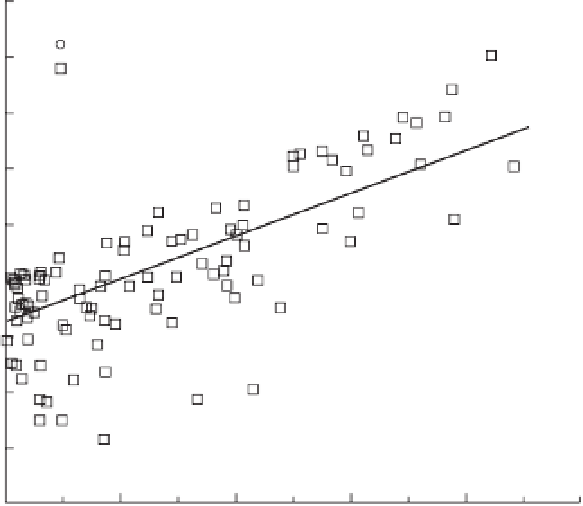Environmental Engineering Reference
In-Depth Information
7.5
Transit paired sample
Single vertical paired sample
6.0
4.5
3.0
1.5
0
Line of least-
squares best fit
-1.5
Fig. 2.5
Relation between sand
bed-load transport rates measured 2
meters apart by a Helley-Smith
bed-load sampler and a BL-86-3
bed-load sampler (the latter identical to
the US-BL-84 bedload sampler), at the
USGS streamgage on the Colorado
River above National Canyon near
Supai, Arizona, USA, October 1989.
From Gray
et al.
(1991).
-3.0
-4.5
-6.0
0 1.5 3.0 4.5 6.0 7.5
Bed-load-transport rate measured by the Helley-Smith sampler (t/day/m)
Flume bed-load sampler calibrations are subject
to at least two serious problems: First, even
with a stable mean bed-load transport rate, the
instantaneous rate normally varies widely about the
mean value (Hamamori 1962; Carey 2005; Gray &
Simões 2008). Second, transport conditions in the
section of the fl ume in which the bed-load sampler
is deployed may differ from those at the fl ume
ground-truth measuring point, such as a slot sampler.
Emmett's (1980) solution to these problems was to
construct a conveyor-belt bed-load trap in a concrete
trough across the bed of the East Fork River, Wyoming,
USA. The trap caught all of the bed load that dropped
into the trough, conveyed it to the stream bank for
weighing and sampling, and returned it to the river
downstream from the trough. This apparatus was
used to collect bed-load data for seven years and to
fi eld-calibrate the Helley-Smith bed-load sampler
(Helley & Smith 1971), the precursor to the US BLH-
84 and US BL-84 bed-load samplers. This work is as
notable for its considerable success in quantifying the
bed-load characteristics of the East Fork River and
calibrating the Helley-Smith bed-load sampler as it is
in highlighting diffi culties and the considerable
expense of obtaining reliable bed-load data.
Field-based comparisons between sequentially or
side-by-side deployed bed-load samplers cannot be
used to identify the absolute sampling effi ciency of
any bed-load sampler without ground-truth data.
However, such comparisons are useful to infer the
relative effi ciency of two or more bed-load samplers.
Childers (1999) compared the relative sampling
characteristics of six pressure-difference bed-load
samplers in high-energy fl ows of the Toutle River at
Coal Bank Bridge near Silver Lake, Washington,
USA. The sampling ratio of each pair of samplers
tested was computed by dividing the mean bed-load
transport rate determined for one sampler by the
mean rate for a second sampler. Ratios of bed-load
transport rates between measured bed-load sample
pairs ranged from 0.40 to 5.73, or more than an
order of magnitude over the relative range of bed-
load sampling effi ciencies. Gray
et al
. (1991) demon-
strated that two pressure-difference bed-load
samplers exhibited divergent sampling effi ciencies
when deployed simultaneously 2 meters apart in the
thalweg of the 76-m-wide sand-bedded Colorado
River above National Canyon, near Supai, in Grand
Canyon, Arizona, USA, under steady low-fl ow con-
ditions (Fig. 2.5).
The accuracy quantifi ed for any bed-load surro-
gate technology can only be as reliable as the accu-
racy of its calibration data. Because bed-load
surrogate technologies require empirical calibrations








